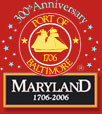
Technology adds extra security …
The Port of Baltimore has a new weapon in its security arsenal called the eModal Truck Checker. Companies that want their trucks to use the Port must register their name and information about the trucks and their drivers. When a truck enters or leaves the Port, its information is instantly compared with information in the eModal Truck Checker. Within seconds, the truck can either be on its way or held up for further inspection.


The Eagle can move over a container in about a minute, scanning for any dangerous cargo.
Safety and security at the Port
Keeping the Port Safe
The Office of Security at the Port of Baltimore has a mission statement that includes these three words: service, awareness, and protection. Their mission has gained new importance since the fear of potential terrorist attacks became part of the fabric of American life.
The Office of Security of the Maryland Port Administration is just one part of the elite network of people and technology whose mission is to protect the Port. This group also includes:
- The U.S. Coast Guard, the lead agency in charge of port security nationwide,
- Maryland Transportation Authority Police,
- Customs and Border Protection, part of the Department of Homeland Security,
- The Federal Bureau of Investigation,
- Baltimore and Baltimore County Police, and
- Private security firms.
Together, all these organization help secure Port operations and the millions of tons of cargo moving through Baltimore’s waterfront each year.
Ports are considered to be highly vulnerable to terrorist attacks because they handle so much cargo entering America from other nations. This is especially true of items shipped in metal containers. Many things can potentially be hidden in the containers, including bombs, weapons, or material to make weapons. Containers are packed and secured before they are put onto vessels entering or leaving America. Ports are also vulnerable because it’s hard to protect such large areas. The Port of Baltimore covers about 40 square miles.
To prevent this from happening, the Port takes special measure:
- All truck drivers transporting hazardous materials must have a commercial driver’s license with a special hazardous materials certificate. These drivers also are fingerprinted.
- Ships entering the Port must send information to the U.S. Coast Guard several days before they arrive, listing the name of the ship, the names of its operators and all crew members, what cargo is on board, and destinations. The Coast Guard and Customs and Border Protection personnel look at the information and decide if they need to inspect the ship’s cargo. If so, they open and inspect a sampling of containers before the ship is allowed to be fully unloaded.
- The Port also has The Eagle, a special x-ray machine that can scan an entire container in less than a minute. This is just one of three types of x-ray screening machines that Port security personnel use to keep America safe.
There are many other security operations at the Port, ranging from boats that patrol the waters between the Port and the Bay Bridge to perimeter fencing and cameras trained on key locations.




